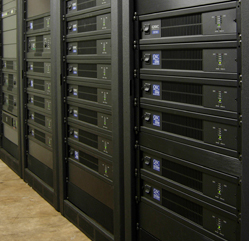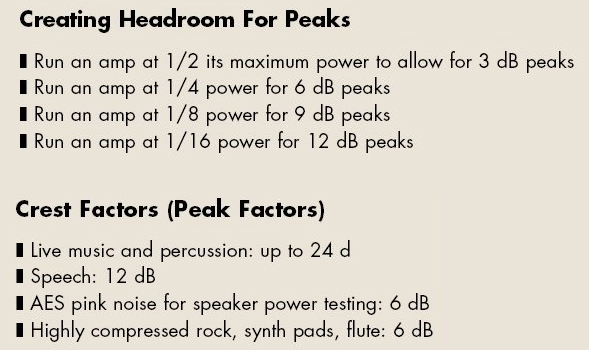
Many power amplifiers include an output limiter to prevent clipping.
If you drive that limiter hard enough, it will reduce the signal peaks frequently, letting you bring up the average level to increase loudness.
I don’t recommend that practice because it will make the amp and loudspeaker run hotter and may cause shutdown.
If the system has no limiter and no operator, the amplifier’s maximum power should equal the loudspeaker’s continuous power rating.
That way the loudspeaker won’t be damaged if the system goes into feedback.
If you are mainly doing light dance music or voice, I recommend that the amplifier power be 1.6 times the Continuous Power rating per channel. If you are doing heavy metal/grunge, try 2.5 times the Continuous Power rating per channel. The amplifier power must be rated for the impedance of the loudspeaker (2, 4, 8 or 16 ohms).
Here’s an example. Suppose the impedance of your loudspeaker is 4 ohms, and its Continuous Power Handling is 100 watts. If you are playing light dance music, the amplifier’s 4-ohm power should be 1.6 x 100 watts or 160 watts continuous per channel. To handle heavy metal/grunge, the amplifier’s 4-ohm power should be 2.5 x 100 watts or 250 watts continuous per channel.
If you use two loudspeakers in parallel per channel, each loudspeaker receives half of the amplifier’s power output. So the amplifier power per channel should be 4 times one loudspeaker’s continuous power rating instead of 2 times.
If both loudspeakers are 8 ohms, refer to the amp’s 4-ohm power spec (because the paralleled impedance is 4 ohms).
Example 1:
Two 8-ohm loudspeakers are wired in parallel to one amplifier channel. Each loudspeaker is rated at 300 watts program. The amplifier should provide 600 watts into 4 ohms per channel. That’s 4X one loudspeaker’s continuous power rating and half the loudspeaker’s impedance.
Example 2:
Two 8-ohm loudspeakers are wired in parallel to an amplifier in bridge mono mode. Each loudspeaker is rated at 300 watts program.
The amplifier should provide 600 watts- continuous (300 watts per loudspeaker) into 4 ohms in bridge-mono mode.
SUMMARY
—Amplifier continuous power should equal 2X the loudspeaker’s continuous power handling (at the same impedance).
—Amplifier continuous power should equal the loudspeaker’s program power handling (at the same impedance).
—If two loudspeakers are wired in parallel, amplifier continuous power should equal 4X one loudspeaker’s continuous power handling (at one half of the loudspeaker’s impedance). Multiply the amp’s power by 80 to 125 percent to get a range of acceptable power levels.

